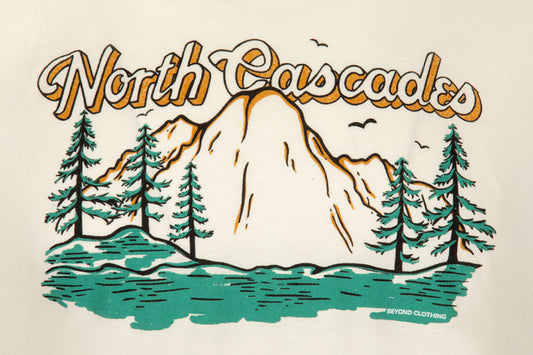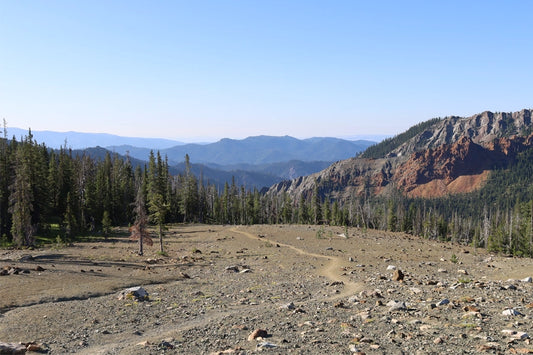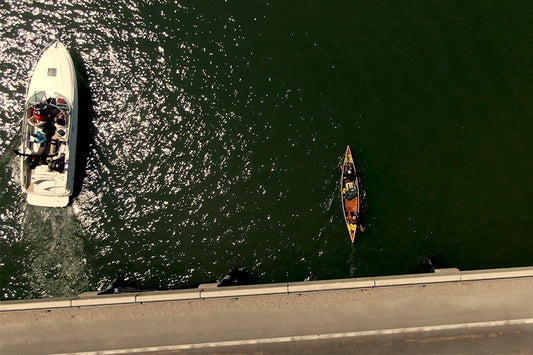During a mission up to Minotaur Lake for our Fall 2018 photoshoot, Paul Clark (SUPPaul) decided to haul one of his SUPS up to the top to explore one of Washington's most epic Alpine Lakes. We had the opportunity to catch up with Paul to talk expedition paddle boarding, whitewater SUP and #vanlife.
Tell us a little about yourself, and how you got into whitewater SUP.
I'm Paul Clark, SUPPAUL aka the “Dufflebag Paddle Boarder.” I have twelve cowlicks and am told I have piercing blue eyes. Scars on my chest come from what I tell people result from saving Honduran street children from a gunfight, but which are actually bruises from sliding on gravel as a kid. Known as the “CatMan,” I express my displeasure by subtly knocking things off table tops.
My background is long distance, self-support trips. I was a sea kayak guide in Alaska and Baja and did a lot of solo-paddling in those places. I got into whitewater SUP after doing a multi-day paddle board trip on the John Day river in Oregon, where I live. If you are going to do long trips on a board in Oregon, you are going to be on the river; and if you are paddling rivers you will eventually have to run whitewater. So, I began the task of teaching myself how to navigate whitewater. Everything I now know about rivers is from a stand up perspective which is kind of unique in the river world where kayaking and boating is the norm. I have gotten a reputation as a river SUP paddler and have become a river SUP clinic host and outfitter.
What is one of your most memorable and challenging trips? Why?
My most challenging river trip was a nine-day 150-mile decent of the Owyhee. Starting in the headwaters of Nevada crossing through Idaho and ending in eastern Oregon, the trip was a first of its kind SUP descent. Most of the trip was through a remote canyon where once I was in it, there was no backing out until the end. The very first day I pinned my board on rocks. After hours spent freeing it, I was able to continue on my way with the board intact. Shallow sections, technical rapids, many portaged around, freezing temps at night, snow during the day, and some days of blazing heat, not to mention the constant headwind, made the expedition memorable.

Running whitewater is inherently dangerous, can you talk about some of the safety precautions that you take?
Running whitewater can be dangerous in any craft. An understanding and respect for the river is key. I think a paddle board is a good vehicle to run Class 1-3 rapids. I teach people how to navigate in a stable stance (“stay low and keep your paddle in the water”) and fall on the board proactively rather than fall in the river. Falling safely and recovering quickly are big parts of running rivers and are fundamental skills taught in my clinics. Yes, you are probably going to end up swimming rapids as a SUP paddler (and it's fun!). But you have a large flotation devise in the form of the board that you can relatively easily climb back onto. You can't say the same thing about kayaking. If you swim from your boat it's bad news, requiring assistance from others.
Wearing appropriate gear is important. A river paddle boarder will look like a ww kayaker, always wearing shoes, a helmet, insulation, a PFD, some padding, and carry a signal device like a whistle. I call this the river SUP uniform, S.H.I.P.P.S. And if you are going to where a leash, make sure it is worn above the waist with a quick release mechanism. Never wear a leash around the ankle while paddling rivers. There have been river SUP fatalities but they have all been associated with improper wearing of the leash.

Can you tell me a bit about what drives you to get on the river and maybe the moment you realized that SUP was something that you had to be doing?
I have always loved being outdoors and self-propelled. Once I started river paddle boarding I began learning about riparian environments and wilderness areas. I have been traveling to many different rivers in the US and abroad, including New Zealand, Japan, and Chile. The diversity of rivers is amazing. The joy of paddle boarding in wild places has been rewarding, and now teaching people how to do is is what drives me.
On that note... it seems like you've committed yourself fully to life on the road in the pursuit of good flows...#vanlife... Can you tell us about some of the perks and challenges of living out of your van?
As a kid I would rip out magazine pages of surfers parked on a remote beach and photographers camped out in the wild. Being mobile, in pursuit, that's the life for me. I'm fortunate to be traveling in a van bouncing around from one river to the next, paddling, photographing, hosting river SUP clinics. Rivers are dynamic and so are the people who use them. I'm so stoked to be in the position to celebrate that diversity. Van lifestyles are hip right now. It's less of a stigma of living in a van down by the river. Many people, athletes, tech workers, millenials are living in vans. It's cheaper than rent in most cases and is a platform for regular travel. It forces a person to simplify, live in well-organized space, conserve resources like water and electricity, and be a good driver. Waking up in a new location every day is great. I'm learning about interior design and carpentry as I begin to customize the outfitting. Having to use public facilities for wifi, bathrooms, showers, and laundromats is a bit of a drag, but well worth the benefits.

This isn't your first stint living in close quarters. What was it like spending a winter in a snow cave?
A van is perhaps one of my more luxurious forms of camping out. Tents, hammocks, snow caves, I love living and sleeping outdoors. Yes, I have spent a winter (over 80 nights) living out of a snow cave. The perfect rent-free abode for a dirtbag ski bum working as a ski instructor!
What advice would you give to someone who is new to the sport and wants to get more involved with whitewater / expedition style SUP trips?
Having hosted river SUP clinics, I have seen people go from little experience to expert athlete. It's great to be part of that journey, helping folks build fundamental skills and advanced techniques. My advise for people getting into rivers or doing expeditions on paddle boards is to bring passion to it. Practice different strokes, paddle at whitewater parks, meet up with different paddlers, take clinics, be inspired by others, watch my videos…. And paddle on your knees. Standing up on a paddle board is a powerful position to be in, but it's one of many on a board. Being able to sit, kneels, stand, do downward dog, etc are all things a SUP paddler are able to do unlike kayakers confined to their boats. I tell my students to find the stance that works for them. Kneeling is a safer way to get through rapids in many instances for newer paddlers to the river.
-
Paul is a super Interesting dude with a really cool perspective on life and we're very excited to have him on the team as one of our explorers. You can check out his explorer page here and follow him on his adventures here.











0 Comments